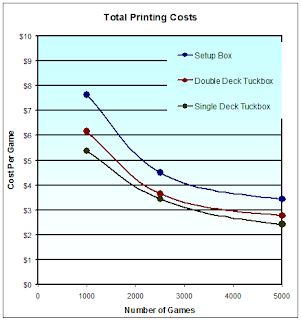The graph at left (click it to make it bigger) shows some results from quotes I've gotten for my card game, Diggity. I thought it might be useful to other game designers and people contemplating publishing their own games to see what I've learned.
Tuck and Setup refer to box types - tuck boxes are one-piece boxes with a flap that tucks in, like a regular playing card box, while setup boxes are usually two pieces (base and lid) with an internal platform for holding the contents in place.
These numbers are tricky to compile and to compare - even though I send the same specifications to each printing company, I don't always get the same results back. For example, some of the quotes include different kinds of boxes, or different box materials, or different card sizes, or different paper stocks and paper coating. Some of them include shipping; others do not, and I have to estimate it, which I've done here. I have only included printing and shipping charges and setup costs where appropriate; no other charges like import duties, file preparation, shipping of samples, etc.
Tuck and Setup refer to box types - tuck boxes are one-piece boxes with a flap that tucks in, like a regular playing card box, while setup boxes are usually two pieces (base and lid) with an internal platform for holding the contents in place.
These numbers are tricky to compile and to compare - even though I send the same specifications to each printing company, I don't always get the same results back. For example, some of the quotes include different kinds of boxes, or different box materials, or different card sizes, or different paper stocks and paper coating. Some of them include shipping; others do not, and I have to estimate it, which I've done here. I have only included printing and shipping charges and setup costs where appropriate; no other charges like import duties, file preparation, shipping of samples, etc.
I often got multiple quotes for different quantities from the same company; these are connected by lines. I sometimes got quotes for different products from the same company, e.g. tuck box vs. setup box (a two-piece box with a bottom and a lid). In this case, I've grouped them with a number; e.g. everything marked "China #1" comes from the same Chinese printer, while "China #2" would be a different Chinese printer.
I'm still pursuing bids, and I will not necessarily go with the lowest bidder here. There are a host of other concerns, such as product quality, the component materials, the box type, my estimates of other costs incurred when dealing with the company involved (which are higher overseas), the professionalism I perceive with the company, and others. I'd love to have a "Made in America" on the label, too, if I can afford it.














